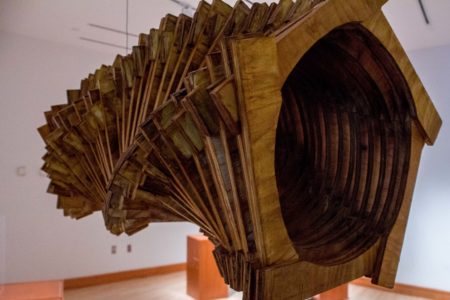
Teresa Fleming
flemingt17@grinnell.edu
In the Smith Gallery show “Unfolding,” artistic evolution plays out over time through a series of ink and charcoal drawings. The detailed line work by Taffe Tang ’17 suggests a significant time investment, but Tang explained that the creative process for her Smith show was surprisingly off the cuff.
“I applied for having a Smith show last semester, and I didn’t hear back, so I thought, okay, I’ll just wait and maybe apply next year or something, and then I got the approval during the summer,” Tang said. “I was in China at the time … and then I started thinking about what to do because I had nothing, and I already had given up on my last set of projects.”
Tang faced practical concerns as she developed her project: any work created over the summer had to be portable enough to carry from her home in Anhui back to Iowa. Inspired by her space constraints, she began working on a series of drawings in a codex, or folded rice paper notebook, that could travel with her compactly but unfold to showcase her collected works on a single long strip of paper. The result is a record of Tang’s summer that unfolds from left to right, featuring a series of images connected by a single black line that extends off the page.
“I thought it was kind of interesting to work separately on each piece of paper without looking at what I did earlier,” Tang said. “What I enjoyed the most of this piece is that I could bring it with me over time, and I could, you know just start drawing whenever I wanted.”
Tang noted that although the show is a first point of contact between her work and the wider world, the pieces featured in “Unfolding” are distinctly personal.
“For me, I know how long it took, what was going on at the time I was drawing. And so I think that part is very personal, and completely about the artist,” Tang said. “When I was little, I was told, if you really have something important to say, draw it instead of writing it into words, because words will disappear.
So when I was little, I used drawings as a way to express my feelings. Most of the time I don’t have a concept of my drawings. So for me, it’s like a visual diary, like written things, but written down in a different, abstract way. It’s like a timeline for me.”
Despite the time crunch she faced in preparing her show, Tang’s pieces highlight the time investment required by detailed works. Her larger pieces, completed later in the semester, represent an effort to incorporate more abstract techniques into her body of work.
“I was in the studio for 16 hours, working on this one piece. I was trying to push more of myself, because of the larger scale, more details, more time and effort,” Tang said. “For most of the time, I measure my effort in terms of time, so I know how many hours I spent on each piece, and it was about time. I really enjoy sitting down and working without stopping.”
For Tang, the labor and time intensive aspects of her work are a uniquely rewarding return to more analog forms of creativity.
“There are a lot of new technologies, printers, laser prints, vinyl cut prints and people are using those to create art. I’m a big fan of technology, but I didn’t want to use any of those for my show, because I wanted it to focus on the original state of art,” Tang said. “I think that’s how most people started with their art life: they started drawing, and they started with simple lines, points, shadows and textures.”



























































